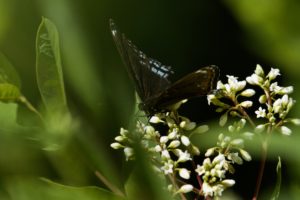Given the weather being experienced in other parts of the country this summer, we are reminded how fortunate we are to live here. The Great Lakes are truly our friends, embracing all the living things here. The mornings this summer have been wonderful, and for those of us working in our nature preserve surveying wildlife and planting trees, the cool, calm mornings and lack of things that bite make for pleasant times.
 Wildlife seems to agree- birds have been abundant in their song and are presently abundant in number in the mulberry tree in our front yard. Flowers have been blooming progressively in our preserve, and as each species blooms, they are pounced upon by insects seeking their nectar and pollen. For pollinators, one usually thinks of the grassland flowers, but there are many which grow in the woods that are amazingly attractive to those same insects, relying on them also for their reproduction.
Wildlife seems to agree- birds have been abundant in their song and are presently abundant in number in the mulberry tree in our front yard. Flowers have been blooming progressively in our preserve, and as each species blooms, they are pounced upon by insects seeking their nectar and pollen. For pollinators, one usually thinks of the grassland flowers, but there are many which grow in the woods that are amazingly attractive to those same insects, relying on them also for their reproduction.In spring, marsh marigolds are abundant here, along with other ephemerals which bloom before the trees leaf out and shade things. Juneberry and serviceberry are early summer bloomers, followed by viburnums like nannyberry and highbush cranberry. Then blackberries and elderberries bloom, the former often covered with many species of bees. The sequence continues throughout summer and fall, with new old favorites coming in to bloom.
At the end of Goodwin Road, at the start of Yellow Birch and other trails, a lot of blooming is happening right now. There are many interesting plants along the road even before one starts the trails- on dry gravel shoulders and wet ditches. There are buttercups, milkweed, and another interesting milkweed-lookalike- dogbane.
Spreading dogbane, Apocynum cannabinum is often found in dense patches in disturbed areas, sometimes right along with milkweed. Its name Apocynum means poisonous to dogs, and cannabinum refers to its fibrous nature, similar to the cannabis plants in the hemp family. It is related to milkweeds, and indeed has milky sap. All parts of the plant are poisonous to humans, cats, dogs, horses- glycosides in the plant causing heart attacks if eaten. However, the nectar borne in clusters of white-pink flowers is definitely not poisonous to insects, and these plants are visited by bees, flies, and butterflies in abundance.
If you find a dogbane patch and are lucky, you may also find one of the most beautiful insects around here- the dogbane beetle Chrysochus auratus. These iridescent little beetles look something like the Japanese beetles we find in our yards eating our roses, but they are a much different insect. Their lives are spent feeding on dogbane, but not to the point of eradication. The dogbanes are their host, and they are very well adapted to live with the plants. Like monarchs and milkweed, these beetles only feed on plants in the genus Apocynum. Adults feed on leaves, in fact concentrating the poisonous glycosides in glands, ready to be used as a chemical defense against predators. The adult beetles live for 40 to 60 days- a very long time in the insect world, and mate almost every day, the females depositing two to three eggs at a time, attached to leaves. The larvae chew through the eggs and fall to the ground, burrowing until they find the dogbane’s roots. They live underground until next spring, when they emerge to feed and mate in the daylight.
Dogbane is an interesting, although poisonous plant. Touching it won’t harm you, and I doubt you’d have any reason to eat it. A patch of dogbane is worth stopping to look at, if not for it’s own pretty flowers, but also the amazing community of creatures which call it home.
photo- red-spotted purple butterfly on dogbane flower by Nancy Nabak
